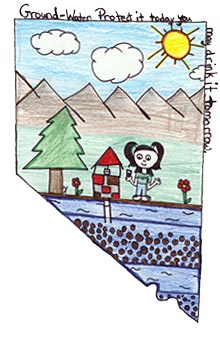Contact EPA Pacific Southwest Groundwater
Pacific Southwest, Region 9
Serving: Arizona, California, Hawaii, Nevada, Pacific Islands, Tribal Nations
Ground Water
National Links
Regional Links

Source Water Protection (SWP)
The Ground Water Office supports Region 9 States, Tribes and the Pacific Islands in their efforts to develop and implement a Source Water Protection (SWP) Program. Source water is untreated water from streams, rivers, lakes, or underground aquifers which is used to supply private wells and public drinking water.
The 1996 Amendments to the Safe Drinking Water Act required states to develop and implement a Source Water Assessment Program (SWAP). Tribes and the Pacific Islands are not required to conduct SWAPs but are encouraged. The Ground Water Office has a Tribal SWP Program which offers technical assistance on SWP issues and funding to conduct assessments and develop/implement SWP programs.
For more information on Region 9's support of SWP in the Pacific Islands, contact:
Ephraim Leon-Guerrero (leon-guerrero.ephraim@epa.gov)
Phone: 415-972-3444
The first phase in a SWP program is to conduct a 4-step source water assessment of your drinking water supply. A key output of SWAP is an assessment of all public drinking water sources (surface and ground water). The assessments are a valuable planning tool which: identify and delineate protection areas surrounding sources of drinking water; inventory potential sources of contamination within those protection areas; evaluate the vulnerability of the sources of drinking water based on the proximity and frequency of sources of contamination; and provide key information necessary to develop and implement source water protection programs. Once an assessment is completed, a community can develop and implement a source water protection (SWP) program that mitigates the identified to the drinking water source(s).
Many communities began their SWP efforts under the Wellhead Protection Program (WHPP). The SWP has grown to go beyond the WHPP’s scope of protecting only ground water sources by focusing on protecting all sources of drinking water, both ground and surface water sources.
All Region 9 States: Arizona, California, Hawaii, and Nevada, ![]() have completed the required assessments.
have completed the required assessments.
With the completion of the assessments, states and/or local authorities can use this information to develop and implement new or additional strategies to protect current and future sources of drinking water.
Source Water Collaboration
Source water protection often involves collaboration on multiple levels with numerous parties because one entity alone is not responsible or capable of providing the necessary protection of an aquifer, watershed, wellhead, or intake.
EPA Regions 8-10, western states, and other source water professionals have begun meeting periodically to advance source water protection collaboration and protection in the West. In May, 2009, approximately fifty participants attended the Western States Source Water and Ground Water Protection Forum at the Asilomar Conference Grounds in Pacific Grove, California.
The Forum brought together source water partners to share and discuss solutions to source water and groundwater protection challenges in the West.
Learn more: Western States Forum Proceedings 2009
Contact information
For general information about the EPA’s SWP program, visit EPA’s national Source Water Protection web site.
For information concerning a Region 9 state’s SWAP/SWP program, go to EPA SWP contact information. For general information regarding implementation of the SWP program in Region 9, contact:
Through a grant provided by EPA, the National Rural Water Association works with communities to develop and implement source water protection plans. If you are interested in learning more about your state Rural Water Association affiliate and what type of technical assistance support they offer, please contact:
Ephraim Leon-Guerrero (leon-guerrero.ephraim@epa.gov)
Phone: 415-972-3444

